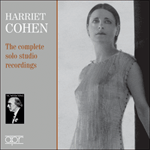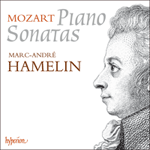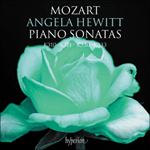The Sonata in C major, K330, combines the galant refinement of J C Bach with a Mozartian subtlety and expressive warmth. Its leisurely first movement (Allegro moderato) is a virtually unbroken flow of limpid lyricism, with minimal contrasts between themes and bouts of brilliant figuration which flatter the amateur’s technique by sounding harder than they really are. The ‘development’ is merely a cue for yet another graceful tune, which is then neatly recalled in the brief coda. At the centre of the soulful F major Andante cantabile is a hushed, mysterious episode in F minor, initially underpinned by a repeated bass pedal. The opening of this episode, now resolved into the major key, reappears in the coda—an inspired afterthought on Mozart’s part that appears in the first edition but not in the autograph. The perky Allegretto finale, akin in spirit to the finale of the A major Piano Concerto, K414, trades on contrasts of ‘solo’ and ‘tutti’. It also shares the first movement’s lyrical profusion, with a homely new tune in the development that would not be out of place in
Die Zauberflöte.
from notes by Richard Wigmore © 2015
La Sonate en ut majeur, K330, combine le raffinement galant de J. C. Bach avec une subtilité et une chaleur expressive très mozartiennes. Son nonchalant premier mouvement (Allegro moderato) est un flot presque continu de lyrisme limpide, avec des thèmes contrastés a minima et des accès de figuration brillante qui flattent la technique de l’amateur en paraissant plus ardus qu’ils ne le sont en réalité. Le «développement» donne juste le signal à un autre air mélodieux clairement rappelé, ensuite, dans la brève coda. Au centre de l’émouvant Andante cantabile en fa majeur se trouve un mystérieux et profond épisode en fa mineur, d’abord étayé par une pédale répétée à la basse. L’ouverture de cet épisode, maintenant résolu en majeur, resurgit dans la coda—une pensée après coup, inspirée, qui apparaît dans l’édition princeps mais pas sur l’autographe. Le gai finale Allegretto, dans l’esprit du finale du Concerto pour piano en la majeur, K414, joue des contrastes entre «solo» et «tutti». Il partage aussi la profusion lyrique du premier mouvement avec, dans le développement, une modeste mélodie nouvelle qui ne déparerait pas
Die Zauberflöte.
extrait des notes rédigées par Richard Wigmore © 2015
Français: Hypérion
Die Sonate in C-Dur, KV 330, verbindet die galante Raffinesse von J. C. Bach mit Mozartscher Subtilität und ausdrucksvoller Wärme. Im gemächlichen ersten Satz (Allegro moderato) fließt die klare Lyrik nahezu ununterbrochen dahin, mit minimalen Kontrasten zwischen Themen und brillant verzierten Passagen, die der Technik des Amateurs schmeicheln, indem sie schwieriger klingen, als sie tatsächlich sind. Die „Durchführung“ ist bloß das Signal für eine weitere graziöse Melodie, die dann in der kurzen Coda geschickt wiederaufgenommen wird. Im Zentrum des gefühlvollen Andante cantabile in F-Dur steht eine gedämpfte, geheimnisvolle Episode in f-Moll, die anfangs von einem wiederholten Orgelpunkt gestützt wird. Der Beginn dieser nun nach Dur aufgelösten Episode kehrt in der Coda wieder—ein inspirierter nachträglicher Einfall von Mozart, der in der Erstausgabe, jedoch nicht im Autograph erscheint. Der letzte Satz, ein munteres Allegretto, gleicht dem Finalsatz des A-Dur-Klavierkonzertes, KV 414, und nutzt die „solo“ und „tutti“-Kontraste. Er weist im ersten Satz die gleiche verschwenderische Lyrik auf und bringt in der Durchführung eine einfache neue Melodie, die auch gut in die
Zauberflöte passen könnte.
aus dem Begleittext von Richard Wigmore © 2015
Deutsch: Christiane Frobenius


 Harriet Cohen - The complete solo studio recordings
Harriet Cohen - The complete solo studio recordings Mozart: Piano Sonatas
Mozart: Piano Sonatas Mozart: Piano Sonatas K310-311 & 330-333
Mozart: Piano Sonatas K310-311 & 330-333
